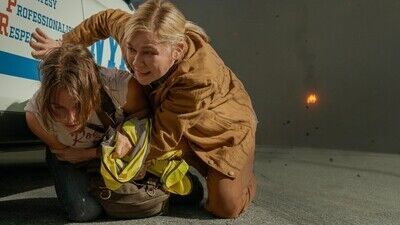As it turns out, “Civil War” is mainly something else: a thought experiment about journalistic ethics, set in a future United States, yet reminiscent of classic movies about Western journalists covering the collapse of foreign countries, such as “The Year of Living Dangerously,” “Salvador,” “Under Fire,” and “Welcome to Sarajevo.”
How utterly bizarre, you might think. And in the abstract, it is bizarre. But “Civil War” is a furiously convincing and disturbing thing when you’re watching it. It’s a great movie that has its own life force. It’s not like anything Garland has made. It’s not like anything anyone has made, even though it contains echoes of dozens of other films (and novels) that appear to have fed the filmmaker’s imagination.
Specifically, and most originally, “Civil War” is a portrait of the mentality of pure reporters, the types of people who are less interested in explaining what things “mean” (in the manner of an editorial writer or “pundit”) than in getting the scoop before the competition, by any means necessary. Whether the scoop takes the form of a written story, a TV news segment, or a still photo that wins a Pulitzer, the quest for the scoop is an end unto itself, and it’s bound up with the massive dopamine hit that that comes from putting oneself in harm’s way. The kinds of obsessive war correspondents who rarely come back to their own countries don’t care about the real-world impact of the political realities encoded within the epic violence they chronicle, or else compartmentalize it to stay focused.
The main characters of “Civil War” are four journalists. The film introduces them covering a clash in New York City between what appear to be police forces from the official government and violent members of the opposition (we have to infer a lot because Garland drops you right into the deep end, as Haskell Wexler did in “Medium Cool,” about a news cameraman covering the 1968 protests in Chicago). Kirsten Dunst plays Lee, a legendary white female photojournalist in the mold of her namesake Lee Miller. She’s partnered with a South American-born reporter named Joel (Wagner Moura). Both are fond of Sammy (veteran character actor Stephen McKinley Henderson), an older African-American journalist who is mobility-impaired and walks slowly on a cane (definitely a liability when covering protests and battles). The group gains a fourth member, Jessie (Cailee Spaeny, the title character of “Priscilla”), a kind of junior version of Lee who idolizes her. Jessie charms the hard-drinking, on-the-prowl Joel and ends up joining the trio as they drive to Washington, D.C. in hopes of interviewing the president (Nick Offerman) before he surrenders to the military forces of something called the WA, or Western Alliance. The WA consists of militias from California and Texas (with secondary support from Florida, which is apparently a different separatist group that shares the WA’s values).

